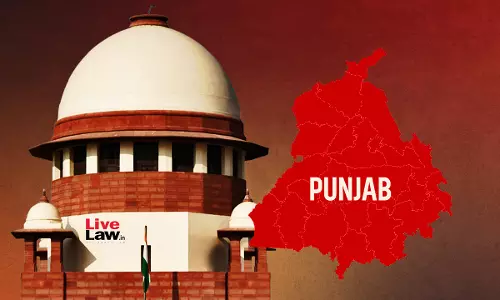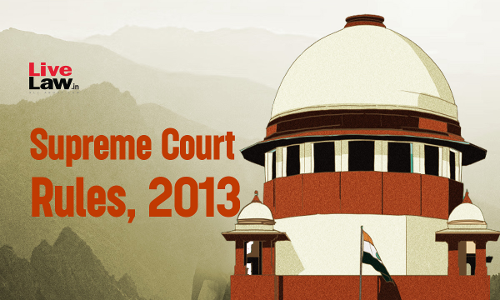NEW SERIES- Questions And Answers For Judicial Service Examinations- By Justice V. Ramkumar [1]- FIR-Part-I
![NEW SERIES- Questions And Answers For Judicial Service Examinations- By Justice V. Ramkumar [1]- FIR-Part-I NEW SERIES- Questions And Answers For Judicial Service Examinations- By Justice V. Ramkumar [1]- FIR-Part-I](https://www.livelaw.in/h-upload/2022/10/31/1500x900_441731-questions-and-answers-for-judiciary-examination-by-justice-v-ramkumar.jpg)
A. INVESTIGATION LEADING TO "POLICE REPORT" OR "COMPLAINT" AND CRIMINAL TRIAL CULMINATING IN THE JUDGMENT A1. INVESTIGATION BY THE POLICE Q.1 What is an FIR? Ans. An FIR is the First Information Report forming the "information" given to the officer-in-charge of a Police station (Station House Officer – "SHO" for short) regarding the commission of a...
A. INVESTIGATION LEADING TO "POLICE REPORT" OR "COMPLAINT" AND CRIMINAL TRIAL CULMINATING IN THE JUDGMENT
A1. INVESTIGATION BY THE POLICE
Q.1 What is an FIR?
Ans. An FIR is the First Information Report forming the "information" given to the officer-in-charge of a Police station (Station House Officer – "SHO" for short) regarding the commission of a cognizable offence and recorded by the SHO under Section 154 Cr.P.C. (Vide para 11 of Apren Joseph @ Current Kunjunju v. State of Kerala (1973) 3 SCC 114 = AIR 1973 SC 1 – 3 Judges - J. M. Shelat – Ag. CJI, I. D. Dua, H. R. Khanna - JJ ).
FIR in a criminal case is an extremely vital and valuable piece of evidence for the purpose of corroborating the oral evidence adduced at the trial. The importance of the above report can hardly be overestimated from the standpoint of the accused alone. The object of insisting upon prompt lodging of the report to the Police is to obtain early information regarding the circumstances in which the crime was committed, the names of the actual culprits and the part played by them as well as the names of the eye witnesses present at the scene of occurrence. Delay in lodging the FIR quite often results in embellishment which is a creature of afterthought. (Vide para 12 of Thulia Kali v. State of T.N. (1972) 3 SCC 393 = AIR 1973 SC 501 – H. R. Khanna, G. K. Mitter - JJ; Meharaj Singh v. State of U.P. (1994) 5 SCC 188 = 1995 Cri.L.J. 457 – Dr. A. S. Anand, Faizan Uddin - JJ).
FIR is in the nature of a complaint or accusation, or at least information of a crime given with the object of setting the Police in motion.
(For a detailed discussion on what is a First Information Statement and First Information Report, please refer to the Article of Justice U.L. Bhat published in 2014 (1) KLT – journal, page 57).
An FIR given to an officer-in-charge of a Police station ("SHO" for short) is registered by him by recourse to Section 154 Cr.P.C. The said Section is reproduced herebelow:-
"Section 154: Information in cognizable cases
(1) Every information relating to the commission of a cognizable offence, if given orally to an officer in charge of a police station, shall be reduced to writing by him or under his direction, and be read over to the informant; and every such information, whether given in writing or reduced to writing as aforesaid, shall be signed by the person giving it, and the substance thereof shall be entered in a book to be kept by such officer in such form as the State Government may prescribe in this behalf:
Provided that if the information is given by the woman against whom an offence under Section 326A, Section 326B, Section 354, Section 354A, Section 354B, Section 354C, Section 354D, Section 376, 55A[Section 376A, Section 376AB, Section 376B, Section 376C, Section 376D, Section 376DA, Section 376DB], Section 376E or Section 509 of the Indian Penal Code (45 of 1860) is alleged to have been committed or attempted, then such information shall be recorded, by a woman police officer or any woman officer:
Provided further that--
(a) in the event that the person against whom an offence under Section 354, Section 354A, Section 354B, Section 354C, Section 354D, Section 376, 55A[Section 376A, Section 376AB, Section 376B, Section 376C, Section 376D, Section 376DA, Section 376DB], Section 376E or Section 509 of the Indian Penal Code (45 of 1860) is alleged to have been committed or attempted, is temporarily or permanently mentally or physically disabled, then such information shall be recorded by a police officer, at the residence of the person seeking to report such offence or at a convenient place of such person's choice, in the presence of an interpreter or a special educator, as the case may be;
(b) the recording of such information shall be videographed;
(c) the police officer shall get the statement of the person recorded by a Judicial Magistrate under clause (a) of sub-section (5A) of Section 164 as soon as possible.
(2) A copy of the information as recorded under sub-section (1) shall be given forthwith, free of cost, to the informant.
(3) Any person, aggrieved by a refusal on the part of an officer in charge of a police station to record the information referred to in sub-section (1) may send the substance of such information, in writing and by post, to the Superintendent of Police concerned who, if satisfied that such information discloses the commission of a cognizable offence, shall either investigate the case himself or direct an investigation to be made by any police officer subordinate to him, in the manner provided by this Code, and such officer shall have all the powers of an officer in charge of the police station in relation to that offence."
So, the "information" given to the SHO should be in respect of a "cognizable offence".
Q.2 What is a cognizable offence and how is it different from a non-cognizable offence?
Ans. Cognizable offence as per Section 2 (c) Cr.P.C. is an offence for which a Police Officer can arrest the offender without a warrant. A non-cognizable offence, as indicated by Section 2 (l) Cr.P.C is an offence for which a police officer has no authority to arrest the offender without a warrant.
Q.3 How to find out whether the offence is a cognizable offence or not?
Ans. Column 4 of the Table given in the First Schedule to Cr.P.C. shows whether the offences are cognizable or non-cognizable. Part I of the said table enumerates the offences under the Indian Penal Code and Part II of the said table shows offences under other laws. If the offence under other law is punishable with imprisonment for 3 years and upwards, then it is cognizable. If it is punishable with imprisonment for less than 3 years, then it is non-cognizable.
Q.4 Why is it that the title of Section 154 Cr.P.C. uses the expression "Cognizable case" when the body of the Section uses only the expression "Cognizable offence"?
Ans. This is because, although an SHO can register an FIR and commence investigation only in the case of a "Cognizable offence", if the case involves two or more offences of which at least one is a "cognizable offence", then there is a deeming provision in Section 155 (4) Cr.P.C that the case shall be treated as a "cognizable case" notwithstanding that the other offences are "non-cognizable". So, if it is a "cognizable case" an SHO can register an FIR and there is no need for all the offences to be "cognizable offences". That is why the title of Section 154 Cr.P.C uses the expression "cognizable case".
Q.5 What is the object of an FIR?
Ans. The object of an FIR from the point of view of the first informant is to set the criminal law in motion and from the point of view of the SHO is to obtain prompt information about the alleged criminal activity before there is time to be forgotten or embellished. (Vide Emperor v. Khwaja Nazir AIR 1945 PC 18 – Goddard, M. Nair, Porter, Simonds – JJ; Paras 31 to 36 of Lalita Kumari v. Govt. of U.P. (2014) 2 SCC 1 = AIR 2014 SC 187 – 5 Judges – P. Sathasivam – CJI, Dr. B. S. Chauhan, Renjana Prakash Desai, Ranjan Gogoi, S. A. Bobde - JJ).
The object of the FIR from the point of view of the informant is to set the criminal law in motion. FIR does not constitute substantive evidence. It can be used only as a previous statement for the purpose of corroborating or contradicting its maker (not any other witness) as contemplated under Sections 157 and 145 of the Evidence Act. (Vide para 6 of Hasib v. State of Bihar (1972) 4 SCC 773 = AIR 1972 SC 283 – 3 Judges – J. M. Shelat, I. D. Dua, S. C. Roy - JJ ).
The fundamental object of an FIR is that it acts as a safeguard against embellishment, exaggeration and forgetfulness etc. Though, recording of an FIR is not a condition precedent to the setting in motion of the criminal investigation, yet from the view of the investigating authorities it conveys to them the earliest information regarding the circumstances in which the crime was committed, the names of the culprits and the role played by them as well as the names of the witnesses present at the scene of occurrence. (Vide para 26 and 24 of State of Maharashtra v. Ahmed Shaikh Babajan (2009) 14 SCC 267 – C. K. Thakker, D. K. Jain - JJ).
The object of insisting on the lodgment of an FIR is to obtain the earliest information regarding the circumstances in which the crime was committed. (Vide para 15 of Ravi Kumar v. State of Punjab (2005) 9 SCC 315 = AIR 2005 SC 1929 – Arijit Pasayat, S. H. Kapadia - JJ).
Justice V Ramkumar is a Former Judge of Kerala High Court
Part 2: Questions And Answers By Justice V. Ramkumar- Investigation By Police-PART II
Part 3: Questions And Answers By Justice V. Ramkumar- Investigation By Police-PART III
Part 4: Questions And Answers By Justice V. Ramkumar(4) -Investigation By Police-PART IV
Part 5: Questions And Answers By Justice V. Ramkumar- Investigation By Police-PART V
Part 6: Questions And Answers By Justice V. Ramkumar- Investigation By Police-PART V


![Last Date to Get 30% Discount On LiveLaw Academys Judicial Service Examination Preparation Courses [Apply Now!] Last Date to Get 30% Discount On LiveLaw Academys Judicial Service Examination Preparation Courses [Apply Now!]](https://www.livelaw.in/h-upload/2025/04/12/500x300_595581-lla-early-bird-750-x-450.webp)

